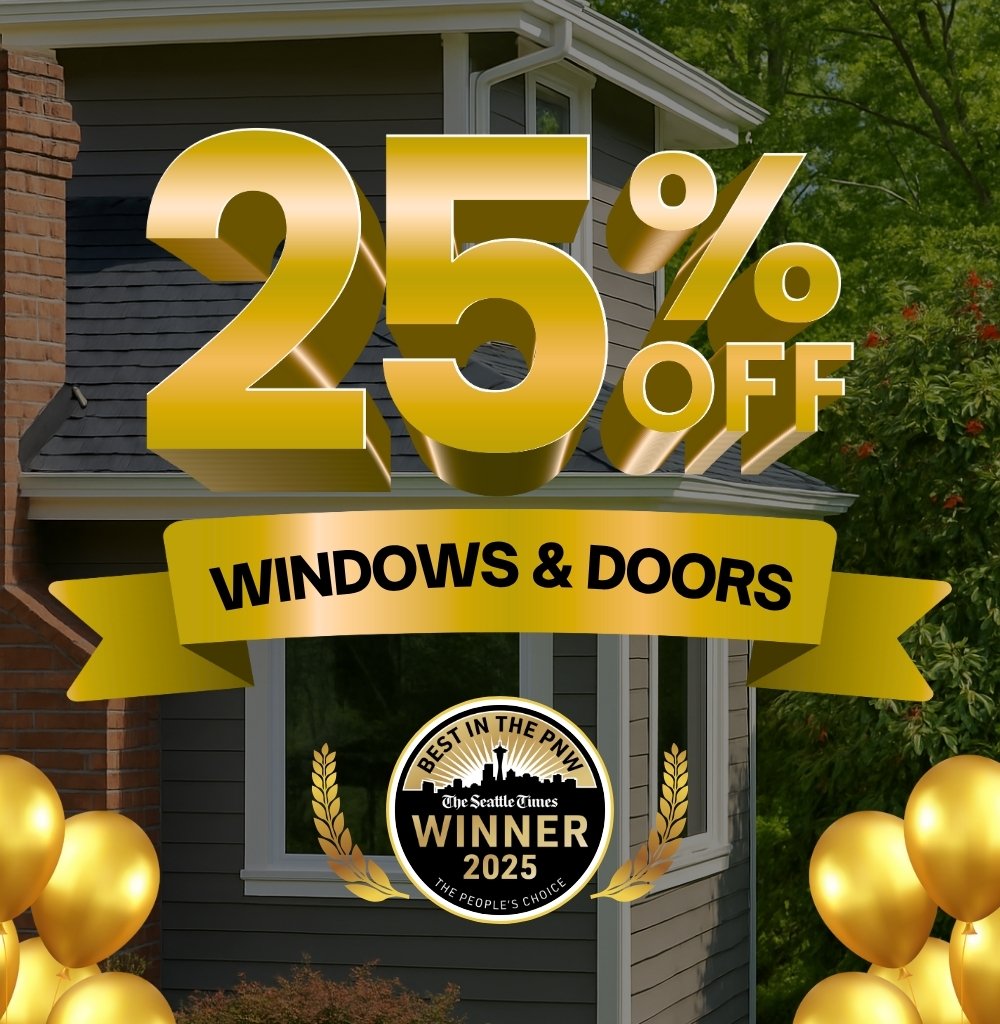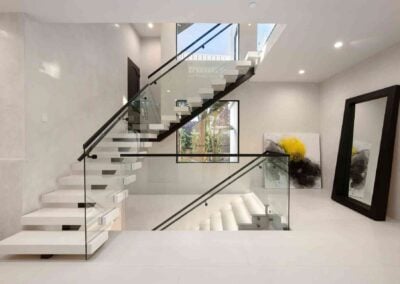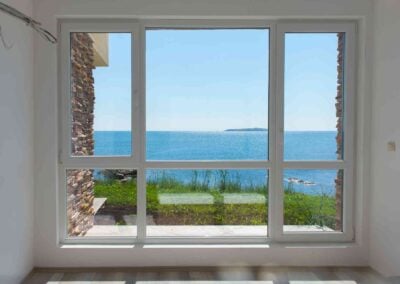Windows affect how your home looks, feels, functions, and performs over time. Two of the most popular operating styles for replacement windows are casement and sliding windows. Each has its own strengths and ideal applications, and understanding these differences can help you make a smarter decision.
Table of Contents
What Are Casement Windows?
Casement windows are hinged on one side and open like a door, typically using a hand crank, allowing the entire sash to swing open to provide maximum ventilation. Because the sash presses firmly against the frame when closed, casement windows create excellent energy efficiency and tight seals against air and water infiltration.
| Pros of Casement Windows | Cons of Casement Windows |
| Casement windows provide maximum airflow by opening fully and catching breezes at various angles. | Casement windows are not ideal in areas where there is limited exterior clearance, such as near walkways or shrubs. |
| They offer excellent energy efficiency thanks to a tight seal when closed. | Crank windows can wear out over time and may require maintenance or replacement. |
| These windows are easy to operate in hard-to-reach places compared to other styles, like double-hung windows. | Casement windows tend to cost more to install due to more complex hardware. |
| Their design provides clear, unobstructed views without a center rail. | They are not compatible with most window air conditioning units. |
| Casement windows can be positioned to catch side breezes and ensure air flows inside. | Opening the sash during high winds can be difficult or awkward. |
| They typically include hook-shaped locks embedded in the frame, offering strong security. | On upper floors, cleaning the exterior glass can be more difficult unless the window swings in far enough. |
What Are Sliding Windows?
Sliding windows operate with two or more sashes gliding past one another horizontally along a track. This design is simple, reliable, and space-efficient. Their space-saving design makes sliding windows a practical choice for wide openings and rooms where an outward-opening window isn’t ideal. Plus, with fewer moving window parts and no hinges or cranks, sliding windows tend to be low-maintenance and easy to use.
| Pros of Sliding Windows | Cons of Sliding Windows |
| Sliding windows are easy to open and close with minimal physical effort. | Sliding windows typically allow less ventilation than casement windows, as only one side opens. |
| Their horizontal design makes them ideal for wide wall openings or large-format installations. | Dirt, dust, and debris can accumulate in the bottom track, which may affect smooth operation over time. |
| Because they don’t swing outward, sliding windows are great for areas with tight exterior clearance, like patios or walkways. | Cleaning the exterior pane can be difficult from inside, especially on upper floors or in multi-story homes. |
| They have fewer moving parts and no cranks or hinges, which reduces long-term maintenance. | Sliding windows often do not seal as tightly as casement windows, making them slightly less energy efficient. |
| The simple, low-profile design fits well in modern and contemporary home styles. | Standard sliding window locks may offer less security than casement locks, unless they are upgraded. |
| Sliding windows are often more affordable than casement windows, especially in larger sizes. | They are not ideal for narrow wall openings or locations where vertical ventilation is preferred. |
| Most sliding windows are compatible with insect screens that stay in place even when the window is open. | The fixed pane cannot be opened, which limits airflow options compared to windows that open fully. |

Schedule a Free Consultation
Get a free home window inspection, talk with one of our design consultants to get product recommendations, and learn about special offers and financing.
The Key Differences Between Sliding and Casement Windows
When comparing casement and sliding windows, the right choice often comes down to how you want the window to function in a specific room. Below is a comparison of the most important features to consider:
| Feature | Sliding Windows | Casement Windows |
| Cost | Typically more affordable, especially for larger sizes | Often more expensive due to hardware and sealing |
| Security | Standard locks may be less secure unless upgraded | Multi-point locking system offers strong security |
| Energy efficiency | Less efficient, especially if track seals wear over time | Very energy efficient due to tight seal when closed |
| Operation | Slides open horizontally along a track | Opens outward using a crank handle |
| Ventilation | Moderate airflow with only one sash operable | Excellent airflow with full sash opening |
| Space requirements | Needs no exterior clearance — great for tight spaces | Requires exterior clearance to open |
| Ease of use | Smooth to operate; ideal for users with limited hand strength | Easy to open in hard-to-reach spots (like over sinks) |
| Maintenance | Minimal maintenance with fewer moving parts | Crank hardware may need repair over time |
| Cleaning | Exterior pane may be difficult to clean on upper levels | Harder to clean exterior from inside, especially upstairs |
| Aesthetic style | Works well with modern and minimalist designs | Complements traditional, craftsman, and cottage-style homes |
| Screen compatibility | Screens stay in place and are easy to remove or clean | Screens mount on the interior side |
| View clarity | Center rail can slightly interrupt sightlines | No center rail allows an unobstructed view |
| Window size options | Ideal for wide horizontal openings | Often better for tall and narrow openings |
| Egress suitability | May not meet egress size requirements in some configurations | Meets egress codes when fully open |
The Cost Difference Between Casement and Sliding Windows
Cost is often the deciding factor when choosing between window styles. While the price difference can vary based on materials, size, glass options, and location, these ballpark figures offer a helpful comparison between the two window styles based on national statistics.
| Window Style | Low-End Installed | Average Installed | High-End Installed |
| Casement Window | $430 | $750 | $1,060 |
| Sliding Window | $415 | $810 | $1,270 |
The Best Place To Install Each Window Style in Your Home
Choosing between casement and sliding windows is also about where and how the window will function. Each style excels in different parts of the home, depending on space constraints, airflow needs, and accessibility.
| Where Casement Windows Work Best | Where Sliding Windows Work Best |
| Kitchens: Casements are perfect kitchen windows that can be installed above sinks or counters where reaching a sliding sash would be difficult. | Living rooms and bedrooms: The wide format offers great views and ventilation without protruding into walkways or outdoor space. |
| Bathrooms: In rooms that need fast, reliable ventilation, plus privacy when desired, the full opening and tight seal help control humidity and odors, making casements an excellent bathroom window. | Basements: Sliding windows are great where there’s limited vertical space or obstructions close to the home. |
| Narrow wall openings: The vertical orientation fits well in tall, narrow spaces that can’t accommodate wider windows. | Hallways, patios, and walkways: The flush design works well in areas with exterior landscaping or foot traffic nearby. |
| Upper stories and multi-story homes: Casement windows can catch angled breezes, drawing in more fresh air than sliding windows. | Modern and contemporary homes: Their clean, horizontal lines match well with minimalist modern or mid-century designs. |
| Cold or noisy areas: The tight seal helps reduce heat loss and blocks more outdoor noise than sliders. | Rental properties and low-maintenance homes: With fewer moving parts, sliding windows are durable, easy to maintain, and cost-effective. |
| Homes with security concerns: Casement windows often include embedded multi-point locks, making them harder to force open. | Homes with frequent screen use: Most sliding windows accommodate fixed-position screens that stay in place when opening or closing the window. |
When To Choose Casement vs. Sliding Windows
Every home and room has different needs. Whether you’re optimizing for airflow, space, ease of use, or aesthetics, choosing the right window style helps improve comfort and functionality. Use this guide to match your goals with the window style that works best.
| What You Want for Your Home | Best Window Style |
| “I want to enjoy maximum ventilation in a small room.” | Casement windows |
| “I want to open a window over my kitchen sink.” | Casement windows |
| “My home is in a windy or cold area, and I want better insulation.” | Casement windows |
| “I prefer a classic look with detailed trim and framing.” | Casement windows |
| “Security is a top concern for my family.” | Casement windows |
| “I want full, unobstructed views without a center bar.” | Casement windows |
| “My room is narrow, but I want to maximize fresh air.” | Casement windows |
| “I need a window that meets egress requirements in a bedroom.” | Casement windows |
| “My home is in a loud area, and I want better sound control.” | Casement windows |
| “I’m building a high-efficiency home with tight air sealing.” | Casement windows |
| “My entire window opening is taller than it is wide.” | Casement windows |
| “I want more architectural character in my window design.” | Casement windows |
| “I have a modern home with wide window openings.” | Sliding windows |
| “I’m updating my basement or ground floor.” | Sliding windows |
| “I need a window that won’t open into a patio or walkway.” | Sliding windows |
| “I want something simple and low maintenance.” | Sliding windows |
| “My window will be opened and closed frequently.” | Sliding windows |
| “I’m remodeling on a tight budget and want something affordable.” | Sliding windows |
| “I need a window with a durable screen that’s easy to clean.” | Sliding windows |
| “I live in a home with wide horizontal wall space.” | Sliding windows |
| “I have limited reach and want an easy-to-slide option.” | Sliding windows |
| “I’m replacing windows in a rental or secondary property.” | Sliding windows |
| “I want a window that blends with my home’s minimalist design.” | Sliding windows |
| “I’m adding more natural light to a room with limited exterior space.” | Sliding windows |
The Importance of Professional Advice When Choosing New Windows
While casement and sliding windows each have clear advantages, the best choice for your home isn’t always obvious, especially when subtle factors like structural details, long-term wear, and local building codes come into play. That’s where professional guidance can make all the difference. A window expert can identify things homeowners often overlook, such as:
- Wall depth and framing constraints may affect whether a casement window can open fully or whether a sliding window will fit flush with the existing trim.
- Exposure to wind and weather patterns could make one window type more durable and leak-resistant than the other in specific parts of your home.
- Egress requirements in bedrooms or basements, where a sliding window might not meet code, but a casement window would.
- Obstructions on the exterior, like shrubs, fencing, or walkways that could interfere with the operation of a casement window.
- Maintenance expectations, especially in hard-to-reach areas. A pro can help you decide which style will be easiest to clean and maintain based on your home’s layout.
- Home security needs, including how different locking mechanisms perform and which upgrades are worth investing in.
- Window size limitations, since some large openings may be better served by sliders for structural reasons, while others may accommodate double casement units.
- Ventilation balance, where a mix of casement and slider windows in the same home may be the best solution.
Get Expert Help Choosing the Right Window Style for Your Home
Selecting between casement and sliding windows can be more complicated than it first appears. Even if you’ve narrowed down your preferences, a professional can help ensure the windows you choose will perform well, meet code, and suit your home’s design for years to come.
At Lake Washington Windows & Doors, our experienced team takes the guesswork out of the process. We’ll walk your home, inspect your openings, and help you choose window styles that offer the best combination of function, aesthetics, and long-term value. Whether you’re replacing a single window or outfitting your entire home, we’ll make sure every detail, from energy performance to hardware finish, is just right. Schedule your free in-home consultation today and let us help you get the right windows in the right places.











